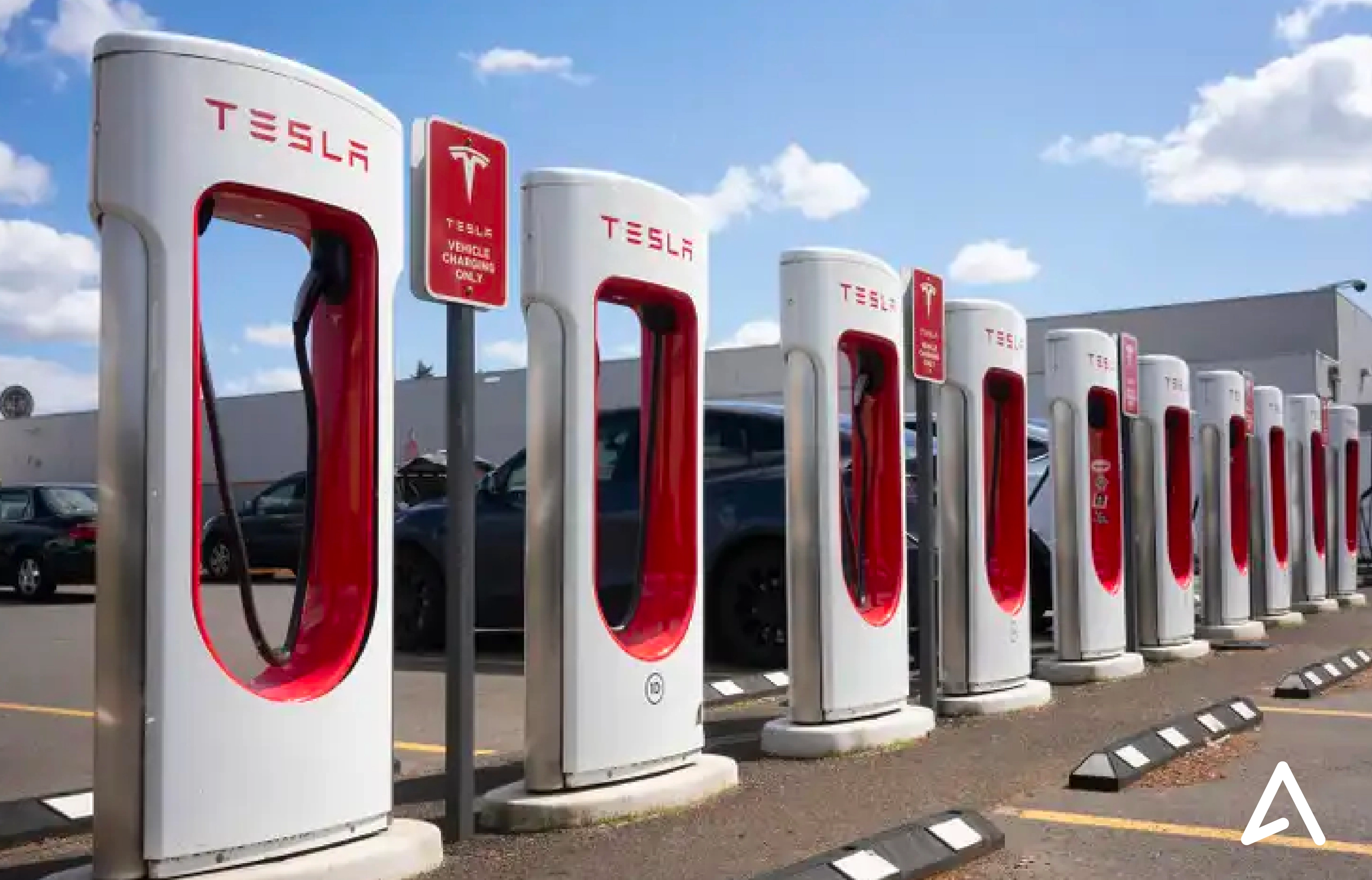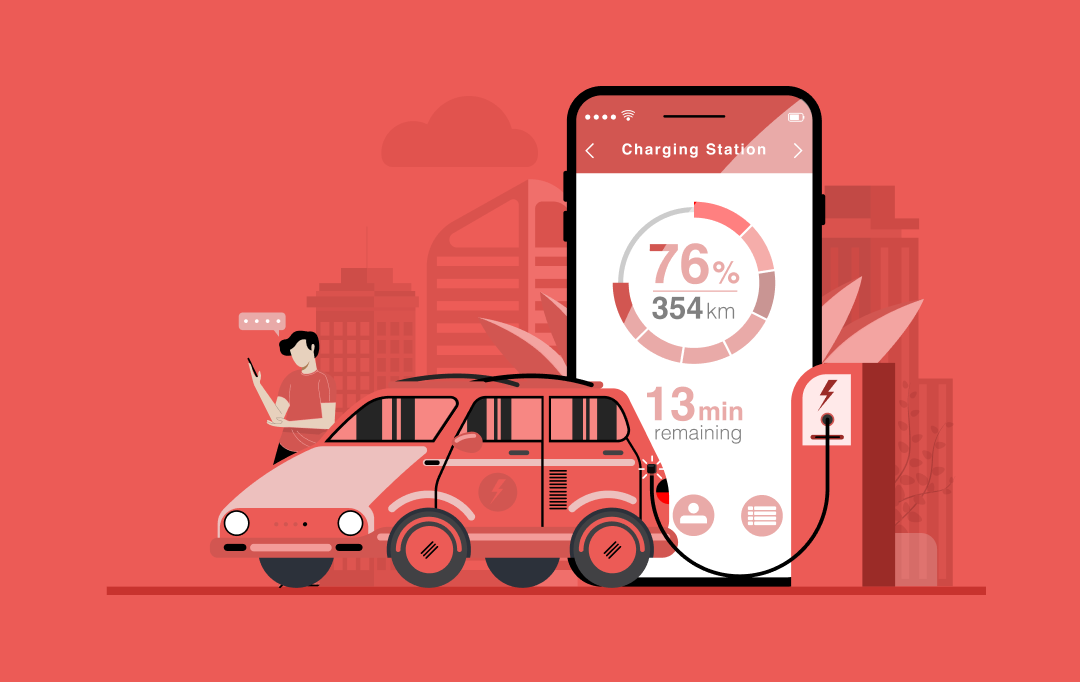- What Makes an EV Charging System Like Tesla Supercharger the Benchmark in the EV Market?
- How to Develop an EV Charging System Like Tesla Supercharger?
- The Hardware Side of EV Fast Charging System Like the Tesla Supercharger
- The Cost of Building an EV Charging System Like the Tesla Supercharger
- How Can Appinventiv Help in Developing Your EV Charging Software?
- FAQs
- Q. How to create an EV fast charging system like Tesla Supercharger?
- Q. How Much does Tesla Supercharger development Cost?
- Q. How long does it take to develop an EV fast charging system like Tesla Supercharger?
Wondering about the costs associated with Tesla Supercharger development? Developing an EV charging system like this can range from $60,000 to $350,000+. This blog explores the increasing demand for EV fast-charging infrastructure, diving into the technological and financial specifics needed to enter the market. Let’s understand how you can capitalize on this growing opportunity in the EV sector.
According to the estimates provided by the Edison Electric Institute, there will be 26 million electric vehicles on US roads by 2030. This will create the need for 140,000 EV fast charging ports, more than ten-fold of the current capacity.
Presenting an even wider gap in the EV charging infrastructure, McKinsey estimates that 1.2 million public EV charging stations and 28 million private chargers would be required to power the US administration’s target of halving the sale of gas-powered vehicles by 2030.
This presents an incredible opportunity for business owners and entrepreneurs to seize the opportunity and bridge the gap by installing public chargers. However, with the charging time it takes for L1 and L2 chargers to fully charge EVs (more details on L1, L2, and L3 later), entrepreneurs and EV operators must look at developing L3 charging stations that give faster charging speeds, such as the Tesla’s Superchargers.
Right off the bat, the Tesla EV Supercharger system development cost is the first thing one would consider when deciding to jump into the EV charging market. To put a number to it, the cost to build an EV charging system like the Tesla supercharger would be somewhere between $60,000 and $350,000 (more details later).
In this article, we’ll discuss all you need to know to make an EV charging system like Tesla Supercharger. However, before we dive into knowing how much do tesla superchargers cost and other details, let us understand what is unique about Tesla Superchargers and what makes these so efficient.
Appinventiv can help you develop cutting-edge EV fast-charging software.
What Makes an EV Charging System Like Tesla Supercharger the Benchmark in the EV Market?
Electric vehicles have been in development for over two decades now. Along with the vehicles, their charging network has been under development parallelly.
Essentially, there are three levels of charging capabilities that are uncreatively dubbed as L1, L2, and L3, ‘L’ denoting the level here. Level 1 chargers provide the lowest charging speeds, and Level 3 chargers offer the fastest charging speeds. The main difference between these three levels of chargers is the power delivery these different levels provide. Let us understand these levels in a bit more detail.

Level 1 (L1) Charging: Level 1 charging infrastructure is the most basic type of charging, and it utilizes a standard 120-volt AC household outlet. Level 1 charging is slow, usually providing 2-5 miles of range per hour of charging, and is best suited for plug-in hybrid electric vehicles or overnight charging for all-electric vehicles. L1 chargers take about 40 to 50 hours to completely charge an electric vehicle.
Level 2 (L2) Charging: This is a faster method of charging, using a 240-volt AC power source, similar to what is used by many larger household appliances. Level 2 chargers typically provide 10-60 miles of range per hour of charging, making them suitable for home, work, and public charging for all types of EVs. This type of charger will take 4 to 10 hours to fully charge a battery electric vehicle.
Level 3 (L3) Charging: Also known as DC fast charging, this is the fastest charging method currently available. It provides a direct current (DC) to the battery, charging it much more quickly than AC methods. This is the level of charging offered by systems like Tesla’s Superchargers, and it can provide hundreds of miles of range per hour of charging. This is the fastest charging available in the EV market, powering up an EV to 100% battery capacity in 60 to 90 minutes. It goes without saying that EV fast charging system benefits are numerous and self-explanatory.
In this article, we’ll be looking at ways to develop an EV charging system like the Tesla supercharger, an L3 charging system, to be specific. An EV fast charging system like Tesla Supercharger is a combination of both software and hardware ingenuity. Electric vehicle software is a key component in the smooth functioning of the EV charging network. In this article, we will be discussing both the software and the hardware side of developing a fast charging system like the Tesla Supercharger.
How to Develop an EV Charging System Like Tesla Supercharger?
Just like any other software development, the development of EV charging management software will involve several steps which, if carried out diligently, will result in software that EV users will come to cherish.
Define Requirements: The development process begins by determining the specific features and functionalities you want your fast-charging software to have. You would like to consider aspects such as user authentication, payment processing, charging station availability, reservation system, real-time charging data, and integration with mapping and navigation services.
Design the User Interface: The next step will involve creating an intuitive, user-friendly interface for both mobile and web platforms. You’ll want to design features such as locating nearby charging stations, monitoring charging status, initiating charging sessions, and accessing billing information.
Backend Development: Build a robust backend system that can handle user authentication, data storage, payment processing, and communication with the charging stations. Building the backend involves developing APIs for interaction between the frontend and backend components.
Charging Station Integration: EV charging interoperability, being a hurdle to EV adoption, is something you’d like to take care of. Utilize standards (such as OCPP – Open Charge Point Protocol) to communicate with the charging hardware installed at the charging stations. Ensure compatibility with various charging standards (e.g., CCS, CHAdeMO) to support multiple EV models. This is an important EV fast charging system feature as it is crucial to support multiple brands of EVs.
Real-time Data and Monitoring: The next step will involve the implementation of a system to collect and display real-time charging data, such as current charging rates, charging time remaining, and station availability. This information helps users make informed decisions about their charging sessions and will optimize the charging times for EV users.
Payment Integration: Set up or develop a secure payment gateway (ensuing compliance with protocols such as PCI DSS) to process user payments for charging sessions. Implement features like prepayment, post-payment, subscription plans, and integration with popular payment providers and utilize multiple payment methods to improve accessibility to the charging software.
Security and Authentication: Implement robust security measures to protect user data, prevent unauthorized access, and secure financial transactions. Use encryption, secure authentication protocols, and regular security audits to ensure the system’s integrity.
Testing and Quality Assurance: After developing the software, you’d like to perform comprehensive testing of the software and infrastructure to identify and resolve any bugs, compatibility issues, or vulnerabilities. Conduct thorough functional, performance, and security testing before deploying the software.
Scalability and Expansion: Design the software with scalability to accommodate increasing numbers of users and charging stations. Prepare for future expansion by considering interoperability with other charging networks and adapting to emerging industry standards.
The Hardware Side of EV Fast Charging System Like the Tesla Supercharger

Designing an EV fast charging system, like the Tesla Supercharger, involves several key components and steps. Here’s the process you should ideally follow to develop the hardware of an EV fast charging system like the Tesla Supercharger.
Design the Charging Station: The station should have power modules, a cooling system, and a charging connector.
- Power Modules: Power modules are the primary components of fast charging systems like the Tesla Superchargers. These are responsible for converting the AC power from the grid into DC power that is used for fast charging of EVs. Fast charging systems require power modules that can handle high power levels. The power module’s design should consider energy efficiency and the capability to provide a wide range of power outputs.
- Cooling System: High-power charging generates a lot of heat, which can damage components and reduce efficiency if not managed. The design should therefore include a cooling system, potentially using liquid cooling, as in Tesla’s superchargers, to manage this heat efficiently.
- Charging Connector: This connector interfaces with the EV to provide power. It should be designed to safely and efficiently transfer high amounts of energy. This part of the design will also need to consider the varying types of connectors used by different EV manufacturers.
Develop a Power Management System: Power management systems regulate the power flow to ensure that charging is safe and efficient. It needs to adjust the charging power based on the electric vehicle’s battery capacity and its state of charge.
Communication Capabilities: The charging system should be able to communicate with the EV to understand its charging requirements. It also needs to communicate with a central billing and usage tracking system. This is facilitated with the use of EV smart energy management systems.
Safety and Compliance: Electric vehicle charging infrastructure needs to be compliant with local laws and other applicable compliances to ensure the safety and reliability of the system.
Our cutting-edge EV software development services are tailored to drive your business forward!
The Cost of Building an EV Charging System Like the Tesla Supercharger
Tesla EV Supercharger system development cost involves several components, with numerous factors influencing the final budget. As mentioned above, the cost to build an EV charging system like Tesla supercharger will range between $60,000 and $350,000.
The primary factors influencing the EV fast charging system development cost include hardware and installation, power supply and grid upgrades, software and networking, and maintenance and operation. Below you will find how these factors affect the final Tesla EV Supercharger system development cost.
- Hardware and Installation: This includes the purchase and installation of charging stations. DC fast chargers, like Tesla’s Superchargers, are expensive due to their high power capacity (up to 250kW). The hardware cost includes the charger unit, construction, electrical work, and other overhead costs.
- Power Supply and Grid Upgrades: Fast charging stations draw significant amounts of power from the grid, often requiring upgrades to local power infrastructure. This might involve the installation of new transformers, cabling, or even a new substation, all of which add to the total tesla super charger costs.
- Software and Networking: While developing charging infrastructure, network setup is required to manage the charging stations, including user identification, billing, remote monitoring, and other smart functionalities. It also includes the integration of these systems into existing power management infrastructure.
- Maintenance and Operation: Regular maintenance is essential for efficient charging station operation that adds to the overall Tesla supercharger cost of development. This includes regular inspections, cleaning, repairs, and component replacements. Operational costs also comprise electricity costs and customer service.
Here is a detailed tesla supercharger cost breakdown
| Cost Element | Average Cost (USD) |
|---|---|
| Hardware and Installation | $10,000 – $50,000 |
| Power Supply and Grid Upgrades | $20,000 – $100,000 |
| Software development | $30,000 – $200,000 |
| Total Cost | $60,000 – $350,000 |
The Tesla EV Supercharger system development cost mentioned above is an average estimate and may not reflect the exact prices for a specific project. EV charging infrastructure is rapidly evolving, and the cost to build an EV charging system like the Tesla supercharger can vary greatly depending on factors like geography, regulations, and technology development.
Also Read: How Much Does It Cost to Build an Advanced Driver Assistance System Like Tesla Autopilot
How Can Appinventiv Help in Developing Your EV Charging Software?
Appinventiv has been at the forefront of the EV revolution sweeping over the world and has unmatched potential when it comes to EV software development. With 1200+ agile developers and cutting-edge capabilities, Appinventiv is an award-winning electric vehicle mobile app development company that has delivered exceptional products to its customers for the last eight years.
We developed a decentralized charging network, Bolt, through which users can find the nearest charging network across a vast number of cities. The Bolt app also lets non-EV users install a charger in their premises, which is quite beneficial for housing complexes, RWAs, parking lots, etc.
Similarly, we developed a smart EV charging platform SemaConnect that allows users to locate and install charging infrastructure. Apart from charging software, we have developed a multitude of solutions for the EV industry, like the customer-facing app of Matter Motors, along with e-scooter booking platforms like Moo and Razor.
With our expertise in AI/ML, cloud computing, custom software development, and other related areas, we have served enterprises and Fortune 500 companies that are at the forefront of their respective industry.
Pioneering the eco-mobility movement, we can assist you in building the software for an EV fast charging system like the Tesla Supercharger. Enabling you to help the US citizens transition to electric vehicles faster, ultimately benefiting the community at large. Contact us to get the exact EV fast charging system development cost and develop your EV fast charging software.
FAQs
Q. How to create an EV fast charging system like Tesla Supercharger?
A. To develop a fast charging system like the Tesla Supercharger, you’ll need to install a high-powered charging unit and connect the unit to the grid. You will also have to develop EV charging management software that will enable fast charging operations.
Q. How Much does Tesla Supercharger development Cost?
A. The Tesla supercharger cost of development can be divided into the software and the hardware cost. The software component of the EV fast charging system will cost around $40,000 to $300,000, depending on the factors discussed above. The hardware component will cost higher and will require significant investment, but the rewards are proportionate.
Q. How long does it take to develop an EV fast charging system like Tesla Supercharger?
A. To develop a fast charging system like the Tesla Supercharger, you’ll have to get the software developed, which can take you 6-12 months, depending on its overall complexity. You will also have to source the charging unit, which will take less time than developing the software. In about 10-18 months, you can operationalize your fast charging system like the Tesla Supercharger.


- In just 2 mins you will get a response
- Your idea is 100% protected by our Non Disclosure Agreement.

How to Build an EV Charging Station Finder App?
Key takeaways: Steps to Build: Empathize with users, define niche, design intuitive UX, choose scalable tech stack, develop lean MVP, test rigorously, and launch regionally with analytics-driven iteration. Costs: Basic MVP ($40K–$100K), feature-rich app ($150K–$300K), enterprise-grade ($400K–$500K+), with 15–20% annual maintenance costs. Core Features: Real-time discovery, intelligent filtering, route planning, user ratings, seamless payments, reservations,…

Smart Grid for Electric Vehicle Charging Infrastructure: Enhancing Energy Efficiency Hack
This rise in the electric vehicles (EVs) market necessitates a robust charging infrastructure and emerging smart grids as the key solution. Electric vehicle charging infrastructure powered by Smart grid technology ensures advanced communication and control systems, enabling dynamic and efficient energy distribution management. This revolutionary approach allows seamless coordination between EV charging stations, utility providers,…

The Nuts and Bolts of EV Management Software for Taxi Fleets
A major portion of the electric vehicle market comprises commercial fleets. And for good reasons. The absence of fuel, heavy automation, and in many cases, a low dependency on drivers makes electric vehicles, or EVs, as they are commonly called, a fleet company's favorite. These benefits have led to a situation where $848.94 Billion of…

















